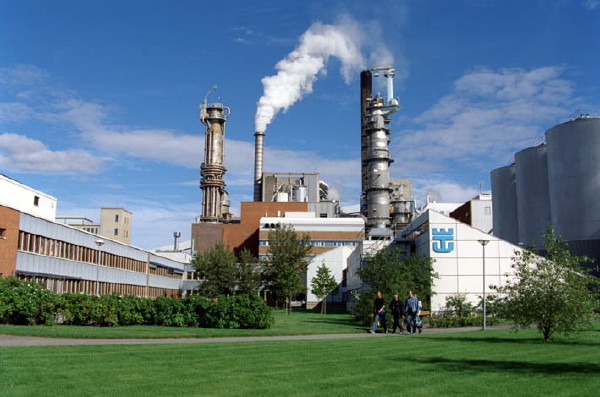Carbon analysis
Each tonne of paperboard made by Iggesund Paperboard in 2008 equated to almost 200 kilos of carbon dioxide being captured and stored in the Holmen Group’s forests. Producing goods and energy from raw materials taken from forests harvested in a sustainable and environmentally sound manner is a strength factor in a world increasingly focused on sustainable development. “This is a major asset to the Scandinavian forest industry and especially to Holmen, which has extensive forest holdings and its own hydroelectric power,” says Lars Strömberg, Director of Sustainable and Environmental Affairs at the Holmen Group.
A carbon analysis, based on research by Skogforsk (the Forestry Research Institute of Sweden) and the Swedish University of Agricultural Sciences, concluded that Holmen’s forest holdings and products annually remove 1.3 million tonnes of CO2 from the atmosphere. The forest’s annual capture of CO2 corresponds to almost 200 kilos of CO2 per tonne of paperboard, paper or wood products that are produced by Iggesund Paperboard, Holmen Paper or Holmen Timber.
“The carbon analysis is an important step on our part to respond to the market’s demands for climate impact reporting,” Strömberg emphasises.
Iggesund reduces its use of fossil fuel
For decades now, Holmen’s subsidiary, Iggesund, has been implementing a long-term environmental programme. The company’s energy supply is based on heat from Iggesund’s own production process plus electricity, almost half of which is produced by the company. Today over 90 percent of this electricity comes from biofuel.
Within a plan to reduce its use of fossil fuel by three-quarters, Iggesund Paperboard will cut its emissions of carbon dioxide from fossil sources by three-quarters at Iggesunds Bruk, the Swedish mill where the company’s flagship product, Invercote, is made. The radical reduction is the result of a detailed energy assessment plus investments totalling about 10.5 million euro, and corresponds to the emissions from 20,000 cars each driven 15,000 kilometres a year.
“But our goal is even higher than this,” says Klas Simes, energy coordinator at Iggesunds Bruk. “We plan a gradual changeover so that we will ultimately not use any fossil fuel at all, and will also be self-sufficient in electricity.”
The reduction in Iggesund Bruk’s carbon dioxide emissions will be implemented in 2009. It will come from a combination of energy savings plus investments in increased capacity for biofuel use. Klas explains that the measures are not primarily motivated by the current intense media discussion of carbon emissions:
“We can’t respond in a short-term, erratic way, like public opinion sometimes does. We have a long-term environmental programme, and environmental aspects are considered when making every investment decision. But our job – and there is no contradiction involved – is to deliver a first-class product at a competitive price. If we want to do this in the long term we have to act systematically and rationally. The huge rises in energy costs in recent years have focused attention on this area. We’ve worked hard to achieve an intelligent solution that ensures our competitiveness – and the reduction of carbon dioxide emissions is just one result of that. We could be self-sufficient in electricity and independent of fossil fuel within the fairly near future,” Klas Simes concludes.
Investments for wastewater purification
Iggesund Paperboard is also investing EUR 27 million to improve wastewater purification at Iggesunds Bruk. The purification facility will come online in the autumn of 2009.
Iggesunds Bruk’s current purification system involves oxygenating the mill wastewater in a biological aerated lagoon before releasing the water into the Baltic Sea. “After having investigated possible additional biological purification stages we have chosen to work with chemical precipitation in the new facility,” explains Iggesunds Bruk mill director Staffan Jonsson. “The process will result in a substantial reduction to the oxygen-consuming substances in the wastewater plus improvements to basically all our other parameters as well. The new treatment facility will enable us to maintain world-class standards for wastewater discharge within the foreseeable future.”

Bioplastic coating
Eventually, Iggesund Paperboard recently announced having received its first order for bioplastic-coated paperboard. This means Invercote can now be supplied with a barrier that is biodegradable and is also made from a renewable source.
“This development is largely market driven but is also well in line with the Holmen Group’s overall environmental approach,” explains Ola Buhrman, product manager for Iggesund Paperboard’s plastic-coated and laminated products. “There is a clear demand for barrier materials that are biodegradable and can be composted.”
For the past couple of years Iggesund has been performing trials using bioplastics as a barrier material. The company has also done an inventory and evaluation of the materials available on the market. The bioplastic coating is done at the company’s paperboard finishing department at Strömsbruk. The most common barrier material in paperboard packaging is polyethylene (PE), a plastic which is neither bio-based nor biodegradable. The bioplastic that Iggesund is now using is biodegradable and meets the European standard EN 13432 for compostability.
“Unfortunately, replacing ordinary PE with bioplastic is not a simple matter – the new materials place higher demands on both production technology and equipment,” Buhrman says.
Current prices for bioplastics are significantly higher than the cost of PE but are expected to fall when availability increases as more and larger production facilities start up.
“ It’s very clear that this development is being driven by the market’s demand for greater environmental awareness, and that customers are prepared to pay more for a biodegradable material,” says Buhrman.




























